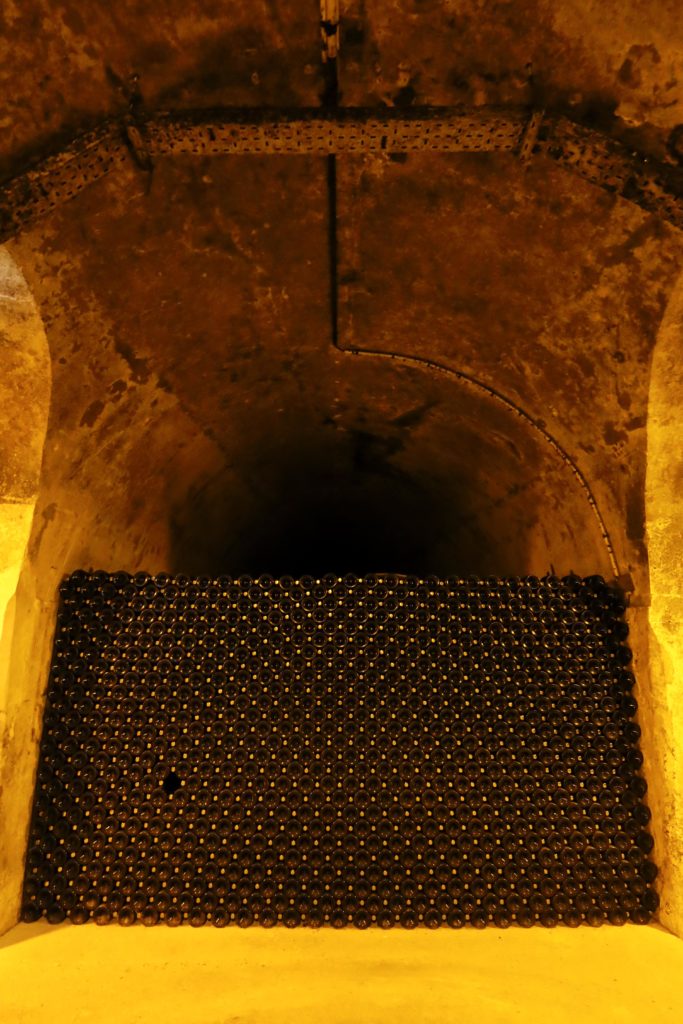 Champagne tour and tasting at Taittinger in Reims, France.
Champagne tour and tasting at Taittinger in Reims, France.
On our recent drive home from Grasse to Calais, we decided to stop over at Reims. Here’s a photo of the beautiful Reims cathedral.
I was last in Reims more than 10 years ago for a French wedding, and all I could remember was a small quaint town, lots of feasting and the customary champagne sampling.
Well, how times have changed. Reims is now bustling with shops and restaurants. One thing has remained the same though, and that is the Champagne.
One thing has remained the same though, and that is the Champagne.  We were kindly invited to tour the major Champagne house Taittinger, and to sample their champagne.
We were kindly invited to tour the major Champagne house Taittinger, and to sample their champagne. Taittinger is one of only five Champagne houses to cellar its wines in the famous “Crayères” of Reims – chalk caves originally dug out by the Romans.
Taittinger is one of only five Champagne houses to cellar its wines in the famous “Crayères” of Reims – chalk caves originally dug out by the Romans.
Champagne merchants found that the caves provided the perfect conditions for aging wine.  The Taittinger cellars are located in the Abbey of Saint-Nicaise, built in the 13th century in Gallo-Roman chalk pits that dated back to the 4th century.
The Taittinger cellars are located in the Abbey of Saint-Nicaise, built in the 13th century in Gallo-Roman chalk pits that dated back to the 4th century.
The Abbey was destroyed during the French revolution, and all that now remains are the cellars.
Above is a reconstructed model of the Abbey. It’s now the location of Taittinger champagne house.
The Taittinger Champagne house did not exist until 1932.  It was originally founded in 1734 by Jacques Fourneaux, then his grandson Jérôme and Antoine Forest started the business, and finally, Pierre Taittinger bought it over.
It was originally founded in 1734 by Jacques Fourneaux, then his grandson Jérôme and Antoine Forest started the business, and finally, Pierre Taittinger bought it over.
Today Taittinger is one of the most famous and largest family run Champagne Houses in Reims.  The vines that make Taittinger Champagne cover 712 acres distributed among some of the best 34 villages in the Champagne appelation area.
The vines that make Taittinger Champagne cover 712 acres distributed among some of the best 34 villages in the Champagne appelation area. I was interested to read that Taittinger extends the aging time of their champagnes beyond the legal minimum time, with three to four years for the Brut Réserve and nearly ten for its prestige cuvée Comtes de Champagne.
I was interested to read that Taittinger extends the aging time of their champagnes beyond the legal minimum time, with three to four years for the Brut Réserve and nearly ten for its prestige cuvée Comtes de Champagne.  During the tour we descended deep into the caves. The lower we went the colder it got.
During the tour we descended deep into the caves. The lower we went the colder it got. The caves were previously used as air raid shelters during the war. You can still see the etchings and carvings on the chalk walls, made by people who sheltered there.
The caves were previously used as air raid shelters during the war. You can still see the etchings and carvings on the chalk walls, made by people who sheltered there. Can you spot a face amongst those chalk walls?
Can you spot a face amongst those chalk walls? The tour was so informative,
The tour was so informative,
Did you know that the names on the labels indicated the sweetness and dryness of the Champagne?
‘Brut’ refers to dry Champagne with low residual sugar. ‘Brut Nature” champagne has the least amount of sugar.
I also learned that “Sec” indicated the sweetness of the Champagne, with ‘extra Sec,’ ‘Sec’ and ‘demi-sec’
Extra Sec is the driest of Champagnes with a sugar content of 12-17 g/l, Sec contains 17-32 g/l and demi-sec is the sweetest with a sugar content of 32 – 50 g/l. How many bottles of champagne do you think are in this tunnel?
How many bottles of champagne do you think are in this tunnel?
Well, the answer is 100,000. Scroll down to see the mirror image of this tunnel, so you can appreciate its depth. Amazing right? Imagine, making so many bottles of champagne to fill up this void.
Amazing right? Imagine, making so many bottles of champagne to fill up this void. Taittinger’s Comtes de Champagne is one of their most recognized and premium Champagnes, and we were lucky to sample it after our tour.
Taittinger’s Comtes de Champagne is one of their most recognized and premium Champagnes, and we were lucky to sample it after our tour.
Made from top quality Chardonnay grapes grown in ‘Grand Cru’ vineyards, Comtes de Champagne is one of the greatest Blanc de Blancs champagnes.
Comtes was first produced in 1952. A Champagne with the potential to age for decades. It was absolutely delicious with light sparkling bubbles and floral citrus notes.
It was absolutely delicious with light sparkling bubbles and floral citrus notes.  We bought a few bottles.
We bought a few bottles.
Finally, I leave you with another fun fact:
Did you know that Champagne bottles have names according to their sizes? For example, a Magnum is 1.5 litres, a Jeroboam is 3 litres and a standard bottle or Champenoise is 75cl.
If you fancy a short break, then I recommend a visit to Reims and a tour of Taittinger.
Have a wonderful week ahead.
